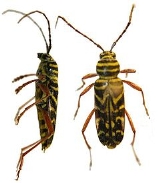
Megacyllene robiniae
Encyclopedia
Common names: Locust Borer
The Locust Borer (M. robiniae) is a serious pest to Robinia pseudoacacia in North America
. The name is derived from the Latin name "Robinia" which is the same as the genus of locust on which the larvae feed.
 Adults lay their eggs in locust trees in the fall, later the larvae will hatch and spend the winter hibernating within the bark. Once winter ends the larvae will burrow into the tree trunk and start to tunnel, these tunnels are around 4 in long and 0.25 in wide. The larvae will then pupate in late July and early August; the adults will start to emerge in late August and throughout September.
Adults lay their eggs in locust trees in the fall, later the larvae will hatch and spend the winter hibernating within the bark. Once winter ends the larvae will burrow into the tree trunk and start to tunnel, these tunnels are around 4 in long and 0.25 in wide. The larvae will then pupate in late July and early August; the adults will start to emerge in late August and throughout September.
Adult food
Larval food
. It is applied in a single dose when adults are most active (August/September).
The Locust Borer (M. robiniae) is a serious pest to Robinia pseudoacacia in North America
North America
North America is a continent wholly within the Northern Hemisphere and almost wholly within the Western Hemisphere. It is also considered a northern subcontinent of the Americas...
. The name is derived from the Latin name "Robinia" which is the same as the genus of locust on which the larvae feed.
Description
From a distance they can easily be mistaken for a wasp or bee, even at a closer look they are often mistaken for M. caryae or M. decora. The adult beetle grows between 12 and 20 mm and have a W-shaped 3rd stripe on their elytra. Both sexes antenna are dark brown while male's antenna are two-thirds its body length and the female's are one-half. Their legs are reddish-brown.Range and habitat
The range has grown over the years seeing as it follows the R. pseudoacacia's range. As more and more people use the Black locust as an ornamental tree the range of M. robiniae grows. They can be found almost anywhere unprotected Black locust grow, often more abundant with Solidago. The females are often found running up and down Black Locust trunks in search for wounds to lay their eggs in. Both sexes are most common from late day to dusk. Because of the adults primary food they tend to stay in uncultivated fields and meadows.Life cycle

Adult food
- Pollen
- Solidago
Larval food
- Robinia pseudoacacia
Pest management
There is currently only one registered product in use which is CarbarylCarbaryl
Carbaryl is a chemical in the carbamate family used chiefly as an insecticide. It is a white crystalline solid commonly sold under the brand name Sevin, a trademark of the Bayer Company. Union Carbide discovered carbaryl and introduced it commercially in 1958...
. It is applied in a single dose when adults are most active (August/September).

